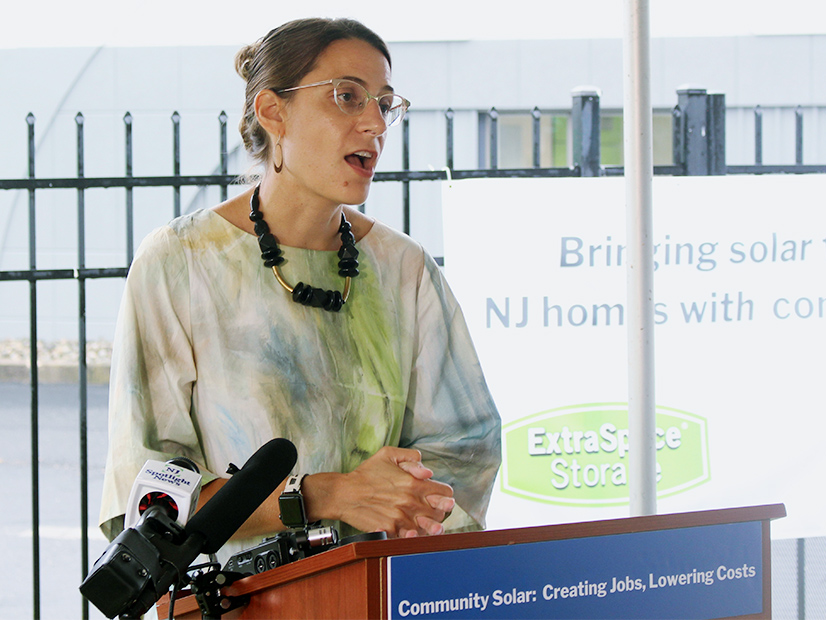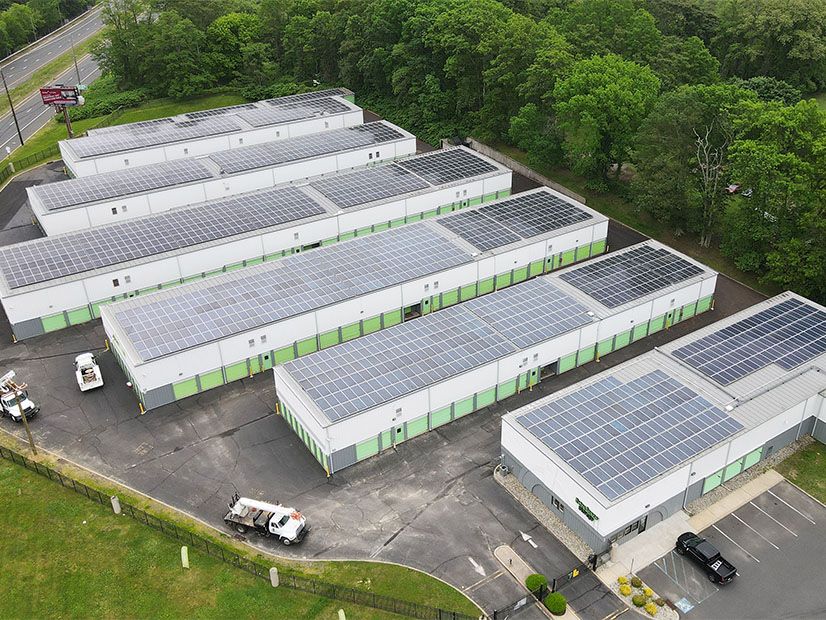
NEPTUNE TOWNSHIP, N.J. — The 500-kW community solar project covering the six roofs of a storage facility in this Northern Jersey town have yet to start pumping out electrons and utility bill savings to subscribers. But that didn’t stop the state Board of Public Utilities from celebrating the project Monday as the first to be completed in the second and final phase of its community solar pilot program.
The pilot was originally planned to run three years, but the large number of projects proposed during the first two years — 150 projects totaling 240 MW — persuaded the BPU to make the program permanent beginning in 2023. A straw proposal for the permanent program could be released in October or November, with the permanent initiative rolled out in early 2023, said Taryn Boland, chief of staff to BPU President Joseph L. Fiordaliso.
The agency earlier said it expects the permanent program to award projects totaling 150 MW each year.
The Neptune project is one of 10 community solar projects developed by Solar Landscape of Asbury Park on 800,000 square feet of roofs owned by Extra Space Storage, of Salt Lake City. Together, they will generate 6.5 MW and generate clean energy for 1,400 households. While completed, the first project is not yet operational due to grid connection issues.
Speaking at an event to celebrate the completion of the first project, Jane Cohen, executive director of the Governor’s Office of Climate Action and the Green Economy, said the Extra Space Storage projects demonstrate the “critical” importance of the community solar program.
 A 500-kW community solar project covering commercial rooftops in Neptune Township, N.J. will provide enough clean electricity to power 1,400 homes. | Solar Landscape
A 500-kW community solar project covering commercial rooftops in Neptune Township, N.J. will provide enough clean electricity to power 1,400 homes. | Solar Landscape
“Community solar is the opportunity for everyone to receive the benefits of clean energy, including those lower energy costs, without the upfront capital, and without having to access a rooftop or ground level space for solar panels,” she said.
Federal officials have taken note of New Jersey’s progress, last week naming it as one of five states that will provide advice and input to a community solar initiative created by the U.S. Department of Energy and the Department of Health and Human Services.
“It’s a big deal,” Cohen said. “This [federal] pilot program will result in cheaper, cleaner energy and a one-stop shop that will remove barriers to accessing these programs.”
The federal agencies will develop an online platform to help households in the Low Income Home Energy Assistance Program (LIHEAP) and other low-income assistance programs sign up for community solar projects in their areas. Administered by HHS, LIHEAP helps low-income families with heating and cooling costs, as well as weatherization and energy-related home repairs. Other states that will advise the project are Colorado, Illinois, New Mexico and New York. (See HUD, DOE Aim to Boost Low-income Community Solar.)
Slow Installation
For all the developer interest in executing community solar projects in New Jersey, however, the pilot program has been slow to get them over the finish line. To date, just 17 of the 150 approved projects have been installed, with a combined capacity of 35.6 MW, or about 15% of the total capacity awarded, BPU records show. About 120 of the approved projects remain in the pipeline, records show.
The program faced criticism last year from developers concerned that the BPU was slow to announce the projects approved in the second phase and create the permanent program. (See Slow Progress of NJ Community Solar Pilot Draws Fire.)
The New Jersey Solar Energy Coalition, which represents 27 companies involved in solar development, said in May that the program has not advanced at the pace expected. Since then, only a few additional projects have come online, and developers have complained that it has been very difficult to get projects connected to the grid in some parts of the state. (See NJ Community Solar Slowly Advances and Solar Developers: NJ’s Aging Grid Can’t Accept New Projects.)
Solar projects across the nation have struggled with supply chain issues in the aftermath of the COVID-19 pandemic, and solar developers say getting municipal approvals has sometimes been slow in New Jersey.
BPU spokesman Peter Peretzman said there “are a number of issues that have resulted in slower than anticipated installation, including some issues common to the entire solar industry and some issues more specific to community solar.
“Our experience with the pilot program affords us an opportunity to understand and seek to address, where possible, the issues causing delays with community solar projects in the design of the permanent program,” he said.
Solar Landscape developed about half of the BPU’s installed projects and has completed all of the eight projects approved to go forward in the first phase of the community solar pilot. Shaun Keegan, the company’s CEO, said one reason for the pace of the company’s project completion is that the rooftop projects Solar Landscape pursues are easier and have fewer permitting difficulties than some other project types, such as carports and those on landfills.
Kevin Dunshee, the company’s chief commercial officer, said the company has worked hard to create a ready pool of trained staff; it recognized that there could be an elevated demand for solar panels, and so created an inventory in advance.
Meeting Low- and Moderate-Income Requirements
The company has not been hindered by the sometimes hard-to-meet BPU program rules designed to ensure that low- and moderate-income households benefit from community solar. The rules require that 51% of the subscribers be from that demographic.
Finding those low- and moderate-income subscribers has not been easy for many community solar developers, who often partner with local non-profit and community organizations to spread the word.
“The 49%, we get pretty quickly,” Dunshee said, adding that they tend to be “people who don’t even necessarily care about the discount, they’re about green energy, they’d like the whole message of community solar.”
The low- and moderate-income portion of the subscribers is more difficult to attract, he said, “because you’re talking about people [who] can’t afford to make mistakes,” due to their economic circumstances.
“I think the most important thing for us is [to provide]) education, getting them to understand that this is a state program, it’s a Board of Public Utilities program, the discounts are guaranteed there’s no cost to get in or out,” he said.
For its Neptune project, Solar Landscape worked with Interfaith Neighbors of nearby Asbury Park, which provides affordable housing, nutrition, neighborhood revitalization and other services, and the Affordable Housing Alliance, a Neptune-based organization that works to provide housing and education.
In a sign of the effectiveness of those partnerships, Solar Landscape announced that it is developing a project on another Extra Space Storage facility in Monmouth County that will provide power for all 130 residents of a nearby low-income property. As a result, 100% of the residents will be subscribers, the company said.

